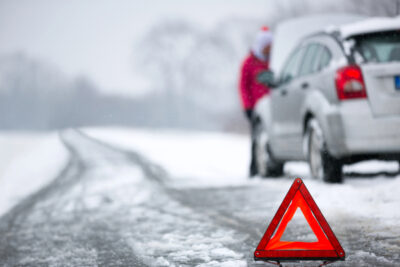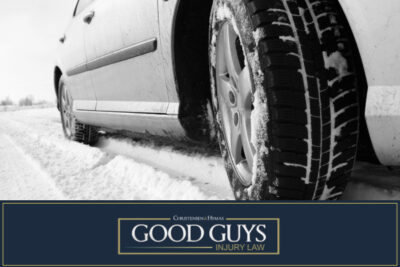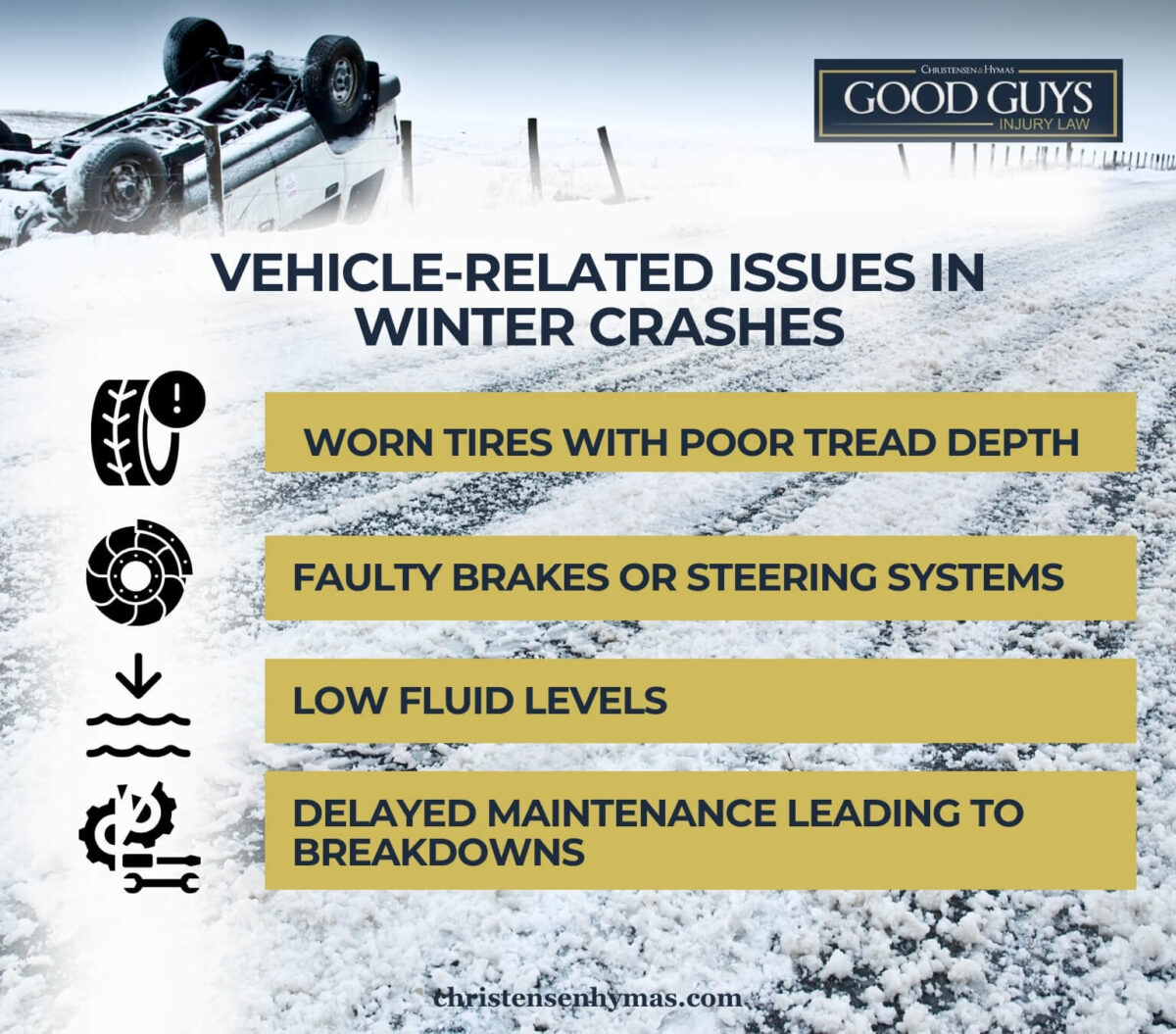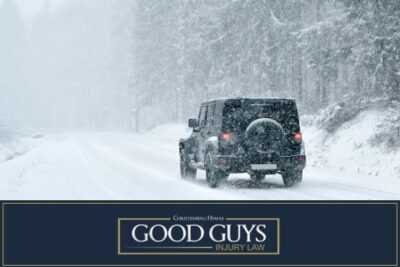
Winter weather brings a unique set of driving challenges many motorists struggle to handle. Freezing temperatures turn roads slick, and heavy snowfall reduces visibility. Even experienced drivers find it harder to maintain control in these conditions. With the right knowledge, you can better understand why crashes happen and how to avoid them. At Good Guys Injury Law, we are here to provide you with that knowledge while fighting for your rights.
No matter your skill level, winter driving demands extra caution. When people fail to adapt their behavior, serious accidents can happen. Awareness of common causes helps you prepare for hazards before they become disasters. Learn more about weather conditions, driver mistakes, and vehicle issues that often lead to winter crashes.

Table of Contents
Weather-Related Hazards Leading to Accidents
Winter brings ice, snow, and darkness, all of which increase the likelihood of a crash. Road surfaces become unpredictable, and other drivers often struggle to see what’s ahead. Awareness of these threats allows you to adjust your driving habits and stay safer. Some of the most common causes of winter car accidents include:
Ice and Black Ice on Roads
Ice forms when freezing temperatures cause moisture on roads to solidify. Black ice appears thin and transparent, making it almost impossible to see until it’s too late. Even a slight turn of the wheel or a gentle press of the brakes can send you sliding. According to the Federal Highway Administration (FHWA), icy roads contribute to yearly winter-weather accidents and all types of car accident injuries.
Snow-Covered or Slushy Pavements
Snow piles up on roads, turning them into slippery surfaces with reduced grip. As traffic moves, it can create slush, a wet mixture that makes braking more difficult. Even all-season tires may struggle to find traction in these conditions. Slower speeds and greater following distances help you maintain control.
Reduced Visibility From Early Darkness
Shorter daylight hours mean many drivers face poor light when commuting. Darkness hides road markings, potholes, and ice patches. Headlights and streetlights create glare on wet or icy roads. Taking it slow and using high-quality headlights helps you see and react more effectively.
Reduced Visibility From Snowfall or Fog
Heavy snowfall or dense fog can lower your ability to spot other vehicles, signs, and hazards. It can also cover your windshield, mirrors, and lights, reducing your vision range. You must rely on your windshield wipers, defrosters, and low-beam headlights to keep sight lines clear. Patience, caution, and frequent checks of your surroundings make a difference.
Driver Errors During Winter Weather

Drivers who fail to adapt their habits to winter conditions often cause preventable crashes. Simple mistakes like going too fast or following too closely become more dangerous on slippery roads. Some of the most common mistakes drivers make in the winter include:
Driving Too Fast for Conditions
Speeding in winter weather ignores the fact that you need longer distances to stop. Icy surfaces reduce traction, and even slight braking can cause skids. By maintaining lower speeds, you give yourself the gift of time to react. Following posted speed limits is good, but slowing down even more during storms is often wiser.
Following Too Closely Behind Other Vehicles
Tailgating poses problems all year, but it becomes worse in winter. If the driver ahead stops suddenly, you may not have enough space to react without sliding. Leaving several extra car lengths between you and the vehicle in front helps prevent rear-end crashes. Remember, slowing down means nothing if you don’t also increase your following distance.
Not Knowing How To Use Brakes in the Winter
Stomping the brake pedal can lock your wheels and send you into a skid. Instead, apply steady, gentle pressure, especially if you have anti-lock brakes. Pumping the brakes in older cars can prevent wheel lock-up and maintain steering control. Practicing these techniques before hitting the highway boosts your confidence.
Overconfidence in Four-Wheel Drive Vehicles
Four-wheel drive improves acceleration on slippery roads but doesn’t help you stop faster. Many drivers believe this feature makes them invincible in bad weather. They risk losing control when they drive too fast or take curves aggressively. Even with advanced technology, respect the conditions and drive responsibly.
Vehicle-Related Issues in Winter Crashes

Cars need special attention to handle winter roads safely. Poor maintenance or worn components reduce your chances of staying in control. The most common vehicle issues that lead to crashes on snowy roads include:
Worn Tires With Poor Tread Depth
Balding tires struggle to grip icy or snowy surfaces. Reduced tread depth means less traction, longer stopping distances, and more skidding. Investing in high-quality winter or all-season tires improves safety. Check tread depth with a simple coin test and replace tires with winter tires if needed.
Faulty Brakes or Steering Systems
Your ability to slow down and steer properly depends on well-maintained brakes and steering parts. Worn pads or leaking brake fluid can compromise stopping power, and loose or damaged steering components may cause erratic handling. Regular inspections by a professional mechanic ensure these systems work as intended.
Low Fluid Levels
Low coolant, windshield washer fluid, and other fluids affect your vehicle’s performance. Running out of washer fluid limits your ability to keep the windshield clear. Coolant keeps the engine from freezing and prevents costly damage. Keeping fluids topped off makes your trip smoother and safer.
Delayed Maintenance Leading to Breakdowns
Postponing routine maintenance can cause breakdowns at the worst times. A dead battery, seized engine, or worn belt can leave you stranded in a snowbank. Proper upkeep helps you avoid these stressful situations. Inspecting and servicing your car before winter hits keeps you on the move.
Preventing Winter Car Accidents

You cannot control the weather, but you can control how you prepare and respond to a car accident. With the right strategies, winter driving becomes less risky. The top strategies to remember include:
- Slow Down. Reducing your speed gives you more time to react. Slower driving also decreases stopping distances and improves control on slippery roads.
- Increase Following Distance. More space between cars allows for safe braking. It lowers the risk of rear-end collisions if the driver ahead stops suddenly.
- Use Proper Tires. Winter or all-season tires provide better traction in snow and ice, helping reduce skidding and improving overall stability.
- Maintain Your Vehicle. Regular inspections and timely repairs keep your car running smoothly. Well-functioning brakes, wipers, and headlights all enhance safety.
- Prepare for Emergencies. Keep blankets, food, flashlights, and shovels in your trunk. These items help if you get stuck and must wait for assistance.
Applying these tips lowers your chances of a crash. With time, care, and attention, winter driving becomes more manageable.
Rely On Our Utah Car Accident Lawyer After a Winter Crash
If a crash happens despite your best efforts, professional guidance can make a big difference. A skilled attorney is familiar with the laws, negotiates with the insurance company, and helps protect your rights. The top ways we can help you include:
- Legal Advice. An experienced lawyer explains your options. They guide you through complex legal rules and regulations.
- Evidence Gathering. Attorneys collect photos, witness statements, and police reports. Strong evidence supports your claim for fair compensation.
- Negotiation With Insurers. A lawyer deals with insurance companies on your behalf. This helps you avoid lowball offers and ensure a better outcome.
- Proving Fault. Your attorney can show who caused the accident. This proof helps you secure the compensation you need.
- Court Representation. If negotiations fail, a lawyer can present your case in court. Skilled advocacy gives you a better chance for success.
With these benefits at your side, the legal process becomes less intimidating. Trusting a lawyer allows you to focus on healing instead of paperwork.



Injured in a car accident? Our Utah Attorney is here to help YOU!
Connect With Our Utah Car Accident Attorney for a Free Case Consultation

Snow accumulation, icy pavement, and poor visibility can increase the chances of a winter auto accident. At Good Guys Injury Law, we understand the dangers of winter weather conditions. We have seen countless winter accidents due to all types of reasons, and we advocate for our clients. If you have a car crash during the winter months, we can help you. Contact us today to schedule a free case consultation.
